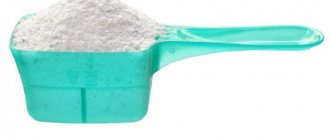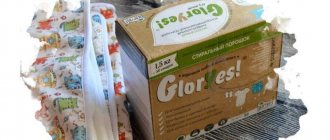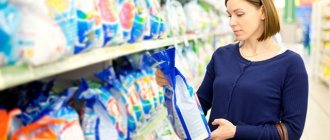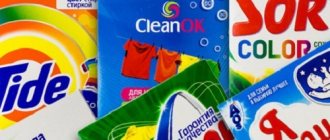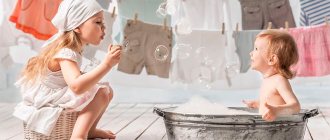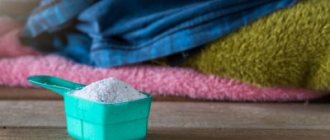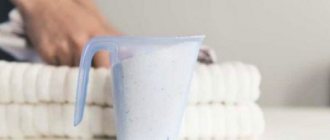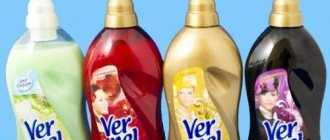Subscribe to our VK community!
With the appearance of a small child in a young family, a logical question immediately arises: what should we use to wash his clothes? Many parents still prefer the laundry soap that our grandmothers used. This is a truly natural product: it does not contain synthetic substances that can cause allergic reactions in the baby. However, more and more people are choosing a special powder for washing children's clothes. It is also made on the basis of natural ingredients and does not cause rash or irritation.
Additional 15% discount on Mepsi household eco-friendly products until March 26 using promo code OZONHBP235 on products from this page! The promotion may end early.
Choosing the most suitable one is not so easy, because there is a wide range of these products on the market. In our article we will try to understand this issue - here we will talk about the best washing powders for children's clothes, and also give some recommendations on choosing the appropriate composition.
About products
As part of a fan study by Roskachestvo, children's washing powders for colored laundry from 22 popular brands on the Russian market were studied (including two for colored children's underwear).
Half of the products are produced in the Russian Federation (11 brands). In addition, powders from four brands from Germany, two brands from the Republic of Belarus, and one each from Australia, Israel, Spain, the USA and South Korea were tested. The testing program included 44 quality and safety indicators. The cost of products ranged from 36.99 to 2340 rubles per unit of product (the study presented products in packages from 350 g to 4 kg). According to the results of laboratory tests, only one brand of children's washing powder (Ushasty Nyan) met not only the requirements of current standards for quality and safety, but also the requirements of the advanced standard of Roskachestvo. Since this is a domestic product, it will be able to qualify for the Russian Quality Mark. Let us remind you that this standard is not mandatory, however, goods that do not meet it will not be able to qualify for the Russian Quality Mark. No products with violations were found.
Russian quality system standard
The Russian quality system standard for children's washing powders has established increased requirements for the quality of the powder. According to them, washing powders should not generate a lot of dust, nor should they leave hardness salts on the heating elements of the washing machine and organic deposits on washed fabric. In addition, washing powders must be completely washed out of the fabric, without making it rough, and flawlessly wash the most common stains. Items washed several times with high-quality powder should not change size, turn grey, yellow, or lose color and strength; There should be no pellets on them.
The required level of product localization for the assignment of the Russian Quality Mark is at least 70% of the cost of the product.
The requirements of the Roskachestvo standard are voluntary and are not mandatory for the manufacturer. If the product meets the advanced requirements of the Roskachestvo standard, the manufacturer receives the right to apply for product labeling with the Russian Quality Mark.
Composition and safety of baby powder
In terms of their component composition, children's washing powders differ from universal ones not in the main ingredients, but rather in additives.
Vyacheslav Filippenkov
General Director of the Scientific Research Center for Household Chemicals (NITSBYTHIM), Candidate of Chemical Sciences, Honorary Chemist of Russia
– Conventional (universal), and especially special (for colored linen, “2 in 1”) laundry detergents may contain additives that must remain on the fabric after washing to impart certain properties. This is not always safe for children, especially infants. These additives are excluded from baby laundry detergents (0+). All other components required for effective washing (surfactants, hardness salt binders, alkaline components, enzymes, peroxide bleaches) are present in children's products.
Therefore, detergents for washing children's clothes will be very effective for washing clothes for adults, but not vice versa!
So, the composition of children's powders may include:
SURFACTANTS
- This is the basis of all washing powders and other detergents. These substances provide wetting of contaminants on the fabric and facilitate their removal or dissolution in water.
PHOSPHATES
– substances that reduce water hardness (things are washed less easily in hard water) and increase the effectiveness of detergent in removing most contaminants. By binding hardness salts, they allow you to have softer laundry after washing, which is especially important when washing children's clothes.
ZEOLITES
They only bind water hardness salts and require the additional introduction of special polymers into the composition.
ENZYMS
– these are dietary supplements that help remove protein, starch (porridge and jelly residues) and a number of other contaminants, as well as pellets. The most common enzymes help break down proteins, so they work best on protein contaminants (for example, blood, dairy products). However, do not use cotton detergents with enzymes (powders and gels) on wool and silk fabrics. They are protein in nature - therefore, they will be destroyed by enzymes.
SUBSTANCES BASED ON CELLULOSE
– thanks to them, the removed particles of contamination do not “stick” to the fabric again.
OPTICAL BLEACHERS
- These are fluorescent substances. By settling on the fibers, they create the illusion of a whiter color and special purity of the item.
There are also many new, “eco-friendly” laundry detergent formulas. They do not contain phosphates, their composition is soap, soda, citric acid, etc. Such washing powders participated in the study (Garden, Molecola and Sodasan). But, according to his results, they did not perform at their best. More on this below.
However, children's powders are subject to more stringent safety requirements, or rather toxicological indicators. Despite this, all powders studied:
- Do not irritate the mucous membranes of the eyes and skin, including do not corrode the skin of the hands (with the recommended use regimen on the package).
- Do not cause intoxication (if tiny particles of powder are inhaled or if they enter the stomach).
- Do not disrupt metabolism (if it enters the blood through the skin).
- Do not cause allergies.
For information
Let's make a reservation in the last point. The study included both flavored and unscented powders. According to the results, neither one nor the other causes allergies. However, many people prefer their washed clothes to smell simply fresh rather than perfumed. Especially for them, there is a list of odorless powders: “Aistenok”, “Mara”, “Umka”, “Chaika”, Babyline, BabySpeci, Frosch, Garden, Sodasan and Tobbi Kids.
In addition, all the powders studied had an optimal pH level of no more than 11.5.
“Detergents for washing children’s underwear are as safe as ordinary universal laundry detergents, it’s just that the laundry washed with them should be safer for a child than washed with an ordinary universal or any special laundry detergent,” comments Vyacheslav Filippenkov
. – And to give mothers greater confidence in the safety of washed baby clothes, we would recommend additionally rinsing them with the highest possible spin rate.
By the way, we looked at how much surfactant remains in the water (and therefore on things) after three standard rinsing cycles. According to test results, the amounts of surfactants that are not washed out of fabrics after washing do not exceed those permitted by the Uniform Sanitary-Epidemiological and Hygienic Requirements. This means they are not dangerous for the child.
Thus, if you follow the instructions for use indicated on the packaging, the washing powder will not cause any harm to the human body. Of course, you cannot eat it, inhale it, or wash your hands with it; it must be kept tightly closed and out of the reach of children.
Attention. These products belong to the category of household chemicals. Read about the exchange and return rules HERE
.
Top 5 good domestic ones
Domestic manufacturers produce a lot of children's washing products. By improving formulas and controlling product quality, they produce effective products that successfully compete with foreign children's laundry detergents.
stork
Aistenok powder is produced in the Russian Federation. This is one of the most popular means that combines effectiveness and affordability. The laundry detergent contains soap, surfactants and other components.
Pros:
- availability;
- hypoallergenic;
- absence of aggressive components;
- good quality of washing and rinsing;
- does not contain dyes or pronounced fragrances.
Disadvantages: the composition of the product is not ideal, according to experts.
Price:
- 4 kg packages - from 500 rubles;
- packaging 0.4 kg – from 55 rub.
You will find reviews here. This article will tell you more about the detergent.
Tobbi Kids
The powder is produced in the Russian Federation. The product has beautiful packaging and a clear division of the group of detergents by age of the child, starting from birth.
The composition is based on a composition of soap and soda. To enhance the quality of washing, non-ionic surfactants, enzymes and other components are added.
Pros:
- good removal of contaminants;
- biodegradable composition;
- no components harmful to children;
- convenient dosing;
- bright packaging;
- high-quality fabric care;
- Suitable for different fabrics.
Minuses:
- will not cope “excellently” with difficult stains;
- not always on sale;
- high price.
Price for minimum volume – up to 100 rubles. Reviews can be found here and here, on this and this review site, and also here.
Umka
Soap powder is intended for caring for a child’s things from birth. Contains:
- soap;
- NSAS;
- sodium carbonate and sulfate;
- fragrance
Advantages of the product:
- efficiency;
- the composition does not provoke allergies;
- safety;
- natural composition;
- high quality control;
- affordable price.
Cons: not always available for sale.
Price: around 80 rubles for 0.4 kg, and 400 rubles for 2.4 kg. You will find reviews here, here and here. More information about the detergent can be found here.
The world of childhood
Baby powder is designed to treat baby's belongings from birth. This is a dry soap product that does not contain chlorine, phosphates, dyes or fragrances.
Pros:
- affordable cost;
- hypoallergenic composition;
- the presence of antibacterial components;
- good washing result;
- soft linen after treatment;
- the fragrance is very light;
- economical use of funds.
Disadvantages: difficult to rinse.
Price: around 50 rubles. Read reviews here and here.
our mother
“Our Mom” is a soap-based laundry detergent for children. It can be used for manual processing of children's things and for automatic processing.
The main component of this product is natural soap, the content of which is up to 35%. It also contains palm and coconut oil. The composition does not contain dyes, flavors or aggressive substances.
Pros:
- natural ingredients in the base;
- high efficiency.
Minuses:
- difficult to rinse;
- foams;
- high price.
Price: about 130 rubles for minimum packaging. Reviews can be found here and here.
Phosphates in baby powders
There are many myths and horrors surrounding the phosphate content in household chemicals. Let's try to dispel them.
Firstly, according to GOST 32479, the powder should contain no more than 17% phosphoric acid compounds. This concentration was not exceeded in any product.
Secondly:
“Phosphates are absolutely safe substances for humans,” says Vyacheslav Filippenkov
. “In essence, these are food additives, in particular, for example, sodium/potassium tripolyphosphate is used to prepare high-grade raw smoked sausage, and phosphoric acid itself (the salt of which is tripolyphosphate) is one of the main components of drinks that are so popular today in our country and throughout the world.” Pepsi and Coca-Cola. Phosphates are also safe for nature, since they are the main fertilizers for most agricultural crops (superphosphate). Naturally, they cannot bring any harm to the child, much less cause allergies. The ban on phosphates in the world is a pure policy that primarily benefits manufacturers of washing powders. Phosphate-free laundry detergents are less effective at removing stains, so they are used more for washing, meaning they need to be consumed and produced more. To increase the effectiveness of phosphate-free laundry detergents, they need to include more expensive components and in larger quantities (surfactants, polymers, hardness salt binders), which make these detergents significantly more expensive than phosphate ones. And this is also beneficial for manufacturers! The consumption of phosphate-free products is higher, the content of substances hazardous to the environment (surfactants, polymers, etc.) in them increases - this leads to more significant pollution not only of water bodies, but also of all nature. But today there is no serious (let alone scientific) evidence of the harm of phosphates to the environment! One argument is that in the late 40s in North America there was an explosion of green algae in the Great Lakes. But this has more to do with reckless use of phosphate fertilizers than with phosphates from laundry detergents. Moreover, in the United States, for 70–80 years after the significant elimination of phosphates from laundry detergents, the Great Lakes have not come to life. So the problem is not with the laundry detergent.
What is better not to use
Experts do not recommend using powders such as Children's Myth, Tide, Pemos and Persil. They contain synthetic components and phosphates, optical brightener and fragrance, a large number of surfactants and toxins.
Such powders are not safe for newborns and are not recommended for washing black clothes, as they leave white streaks, stains and marks.
Children's Myth is suitable for children over two years of age without allergies. It will wash white clothes and protect the washing machine from scale. Children's Tide has a softer and soothing effect due to the content of aloe vera and chamomile extract.
Children's Pemos has the worst toxicity indicator, so it is extremely harmful to health. And the largest amount of surfactants is observed in Pemos.
When washing, you can also use folk remedies from soda and soap or dry borax. These are soft and safe formulations that are easy to prepare at home. However, you cannot constantly use homemade powders or gels, as they do not provide 100% cleaning results.
Therefore, experts advise alternating home and household remedies. How you can replace washing powder, see the link.
Dust in the eyes
Washing powder, like any other, generates dust. This dust can get into your eyes, nose and mouth and cause irritation by drying out your mucous membranes. However, as stated above, we have not confirmed this experimentally. But still, to be on the safe side, the Roskachestvo standard established standards for the amount of dust in baby powder (it should be no more than 5%). All the powders studied met these standards with a margin: the mass fraction of dust in them did not exceed 1.2%. Despite this, tests showed that the powders of the three brands produced a lot of dust. Moreover, this was not due to the amount of dust or the size of the granules (granules of 0.2–2.5 mm prevail in all powders), but to the component composition.
“The dust in these cases is most likely sodium sulfate,” says Vyacheslav Filippenkov
. – In itself, it is not very dangerous, but its dust is very unpleasant, and it causes severe sneezing. It would be very dangerous if there were enzyme particles in the dust! Probably, the heavy dusting of these powders is associated with their production technology. The correct technology requires fixing dust-like components (for example, sodium sulfate) on the surface of the granules using a liquid component (water or nonionic surfactants). Then there will be no dust. At the same time, the product becomes more homogeneous. If this is not done and the powder was made by dry mixing of powdered and granular components, the mixture will be heterogeneous, with very low humidity and will begin to generate a lot of dust when poured.
Attention. This product belongs to the household chemicals category. Read about the exchange and return rules HERE
.
Criterias of choice
How not to make a mistake when choosing powder for newborns? What aspects in product descriptions should you pay special attention to? It should be borne in mind that such products are the brainchild of the chemical industry, so one way or another, an allergic reaction may occur even if the product does not contain any dangerous additives. Substances that contain a minimum amount of aggressive substances are considered hypoallergenic or safe. What components can cause a rash or other allergic reaction? The main names are shown in the comparative table:
| Type | Review |
| Fragrances | A pleasant aroma in practice can turn out to be a malicious pest. An adult will like this smell, but not a child, whose receptors work differently from their parents. Damage to the respiratory system can eventually develop into asthma. If you plan to make things more fragrant, then it is better to give preference to natural oils. |
| Surfactant | It is the basis of the detergent. Among all types, anionic ones are considered the most aggressive. They are able to penetrate the body through the skin, which affects the functioning of internal organs and the central nervous system. In addition, there is a noticeable decrease in the functioning of the immune system. The acceptable rate is 15%. For household use, experts advise giving preference to nonionic substances, no more than 5% of the total weight. Almost every online store has a section with organic surfactants, which are based exclusively on vegetable fats and oils. |
| Bleaches | The concentration reaches 0.2-0.4% of the declared net. Used to refresh the appearance of white items. What are they: 1. Optical. Their use in children's powders contradicts not only the instructions of Roskachestvo, but also the current legislation. Unable to wash completely. The principle of operation is simple: they contain microparticles that reflect light rays, which gives things the appearance of amazing cleanliness. 2. Chlorine. Cannot be found in substances intended for the care of children's clothing. Irritates the mucous membranes of the throat, nose and eyes. Direct contact with skin will result in burns or severe redness. An excellent disinfectant and bleach. 3. Oxygen ones are the best. They are expensive, but can be used in products intended for children. They are considered not only safe, but also effective and environmentally friendly. |
| Phosphonates or phosphates | Such components are dangerous not only for the youngest children, but also for their parents. They are used to increase the cleaning ability of the powder, eliminate scale build-up in the washing machine and soften water. They lead to disruption of the natural balance of the epidermis. Promote the appearance of rashes, redness, itching and other allergic reactions. Can penetrate the bloodstream through the skin. The potency of phosphonates is lower than that of phosphates. In order to wash them completely, it is enough to rinse the items several times. |
In addition to standard recommendations from Rospotrebnadzor, you should pay attention to numerous reviews on the Internet. Almost any powder can cope with the indicated functions, however, the price for such success may vary. According to buyers, it is better to wash not only children’s clothes, but also adults’ clothes with baby powders. Do not forget that children spend a lot of time outside their crib in the arms or parent's bed.
The best baby powders for washing quality
Children are children. And children's clothes, of course, have to be washed very often. Experts from Roskachestvo assessed how well the powders remove protein stains (for example, blood, etc.) and pigment-oil stains (for example, oil, grease, etc.). It turned out that 14 powders dealt with greasy stains perfectly, and 17 powders did an excellent job with protein stains.
Interestingly, in general, children's powders did a better job of removing grease stains than universal ones.
Also, Roskachestvo experts tested how baby detergents wash motor oil, sweat (sebum - sweat fat), blood with milk, blood, starch, tea and clay. Tests were carried out both in a laboratory machine (to evaluate the effectiveness of the composition) and in a household one. It turns out that stain remover is not always needed. Children's powders “Aistenok”, “Eared Nanny”, Free Time, Meine LIEBE and Tide did an excellent job of removing all the stains listed.
You can see the rating of children's powders based on their ability to remove various stains HERE
.
However, let’s focus on one of the listed stains – tea. It turns out that this contamination was included in the test program for more than just one purpose.
“The degree of removal of tea contaminants during the washing process is a qualitative reaction to the effectiveness of bleaches in powder,” says Vyacheslav Filippenkov
. – More often we wash things not because they have become dirty, but to refresh what we have worn: sweat and bacteria remain on things, which in the future can lead to an unpleasant odor and yellowing of things. Therefore, these bacteria must be killed during the washing process! Powdered laundry detergents that contain chemical (peroxide) bleaches cope most effectively with this. They kill most household bacteria, eliminating the subsequent appearance of unpleasant odors, and also remove yellowness and most food and natural colored stains. Removing a tea stain clearly demonstrates the effectiveness of the bleach included in the powder.
How to choose
Due to the fact that the skin of babies is too sensitive and susceptible to irritation and allergies, it is worth taking a responsible approach to the choice of washing powder. It is worth paying attention to the following parameters and recommendations:
| Compound | As we have already found out, it is important that the composition did not contain phosphates, chlorine, or fragrances, which can cause allergies in the baby. Laundry soap, plant extracts, and natural ingredients are considered safe for children. |
| Form of remedy | It comes in gel and powder form. The liquid version, unlike the powder form, has a more gentle composition, is completely washed off from the fibers, is effective in cool water, and is safe for the respiratory system. |
| Brand | It is preferable to choose powders and gels from well-known brands: Ushasty Nyan, Stork, Tide. |
It is important to contact your pediatrician when the first symptoms of an allergic reaction appear.
How powders affect things
Among other things, Roskachestvo experts studied how powders affect washed items. Let us immediately note that all detected deficiencies are not violations. Products with them are simply deprived of the opportunity to qualify for the Russian Quality Mark.
For example, the test program included an indicator of the residue after ignition (ash content). The higher the percentage of ash content, the more minerals will be retained in the fabric - the fabric will coarse, become harder to the touch, as if starched. This is especially undesirable for children's delicate skin. The Roskachestvo standard has established that ash content should be no higher than 2%. Baby powders from 18 brands met this requirement. Amway
Home
powder has zero ash content .
It does not make the washed items rough at all. For two brands of products, the ash content was slightly higher than two percent, and for two other brands it was unacceptably higher. We are talking about Free Time
(6.4%) and
“Mara”
(4.6%) powders. Most likely, things washed with these powders will begin to become rough over time.
After 25 washes at a water temperature of 40°C, things turned gray only in one case (when washed with Molecola
) and in none of them did they turn yellow (although in two cases yellowing was possible over time, with more washings).
In addition, things did not shrink after washing (they did not change sizes after washing and drying) and did not lose strength either in width or length. More details can be found in the product cards HERE
. Note that the powders studied, not for children's underwear, damaged the fabric more. Thus, one of the powders reduced the strength of items after 25 washes by 45%!
Also, when studying children's powders, most of them showed a “blueing” effect, and in the powder of one TM it turned out to be the most pronounced. That is, many things visually seemed fresher after washing.
Tests on the effect of the powder on the loss of color of things were carried out on samples of knitted fabrics in red, crimson, black, blue and mustard colors. As a result, after 15 washes at 40°C with Aistenok
,
“Spring Tenderness”
,
“Mara”
,
“Eared Nanny”
,
“I Was Born”
,
Burti
,
Frosch
and
Reflect
samples of all colors retained their bright colors . After washing with other powders, some or all of the colors faded partially or completely.
As we can see, there was also an egregious case when the powder irreversibly damaged the samples. We are talking about the product TM Garden
. You can compare photos of samples before and after washing with this product.
We also assessed how the color of items previously “aged” (that is, washed 25 times at 60 °C with universal powder) would change after washing with baby powders. Interestingly, the mustard color of the samples was restored in 11 cases. In one case, the red color of the sample was restored. Well, in three cases we encountered an even greater loss of color. Garden again
,
Molecola
and
Sodasan
. Note that these powders are “eco-friendly” and are made from soap.
Soap products, as it turned out, really spoil the color of things.
But after 15 washes at 40 °C, no pilling appeared on clothes washed with all the powders tested. You can safely wash even knitwear, because it is more susceptible to their formation than other materials.
Useful tips
Stains on diapers and clothes of a newborn are better removed in cold water. Rub problem areas with laundry soap and soak in a basin for several hours. Then wash as usual.
You can remove a fresh stain on clothing with a damp cloth. If the stain does remain, it will be easier to remove during washing.
Dealing with complex old stains is more difficult. To do this, you need to treat the stain with laundry soap and wash it. In especially difficult cases, use stain removers for children's clothes.
Following practical advice, you can prepare diapers and clothes for your baby at the maternity hospital. Choosing a detergent is not difficult if you pay attention to the composition. It is better to use gel to clean newborn clothes. It is convenient, practical and safe. Maintain the temperature conditions to preserve the original appearance of things for a long time.
A lot of foam - a lot of problems
As we found out when researching baby soap, you need a lot of foam to wash your hands well. The same condition is necessary for washing by hand or in an activator-type washing machine (with top loading). However, for washing in an automatic drum-type washing machine (with front loading, they are in most people's homes), an abundance of foam is contraindicated. Firstly, the quality of washing deteriorates, and secondly, foam can flow out of the machine drum onto the floor and cause a short circuit. This is especially dangerous and can lead to tragedy if a small child is running nearby.
For information
Many machine wash powders contain defoamers. Interestingly, dirty laundry also acts as a foam absorber. The dirtier the laundry is initially, the less foam there will be.
According to the requirements of GOST-32479, the washing powder should produce no more than 180 millimeters of foam (for products with standardized foaming for front-loading washing machines). When studying washing powders for washing colored clothes, it turned out that powders from 11 brands did not meet this requirement. Of the powders for children's underwear, only the product of one TM did not meet the increased requirements of the Roskachestvo standard - Sodasan
(198 mm foam).
In turn, the powders that form the least amount of foam are “Aistenok”
,
“Dosenka”
,
“Umka”
,
Garden
,
Molecola
and
Tobbi Kids
.
In this regard, there are two important rules for washing in a machine:
- For machine washing, use only products intended for it: those with a picture of a front-loading machine or just a hatch. Hand washing detergents can create a lot of foam.
- Follow the powder dosage recommended on the package.
Rules for washing in an automatic machine
When washing children's clothes in a washing machine, it is recommended to consider a number of rules:
- Strictly dose detergent. This must be done in accordance with the manufacturer's recommendations on the packaging.
- Wash diapers and bedding at a water temperature of at least 90 degrees, clothes - 40 degrees.
- Wash in the “baby clothes” mode. If the machine does not have such a function, use 2-3 rinses.
- Heavily soiled items should be pre-soaked in a soap solution prepared from warm water and grated soap.
Can baby powder break a washing machine?
Tap water and tap water are very hard due to the excess of mineral salts in it: calcium and magnesium. These hardness salts remain on the heating elements of household appliances (kettles, coffee machines, dishwashers), forming scale on them - we find it at the bottom of the kettle in the form of a white coating. The washing machine is no exception. Scale can accumulate on the heating element, and the machine will break down and burn out. In turn, certain components of the laundry detergent promote the growth of such deposits, which increases the likelihood of breakdown.
To reduce the risk of burnout, it is better to use washing powders that deposit a small amount of salts on the heating elements of the machine. These are the majority among the studied children's powders. Aistenok brand.
,
“Dosenka”
,
“Mara”
,
“Spring Tenderness”
,
“Eared Nanny”
,
The Seagull”
,
“I Was Born”
,
BabySpeci
,
Burti
,
Frosch
,
Garden
,
Meine LIEBE
,
PoshOne
and
Tobbi Kids
.
How to protect your washing machine from this and other breakdowns, read HERE
.
We also checked how many organic compounds baby powders leave on the drum of the machine. It turned out that only two powders left too much of them. These are again eco-friendly soap powders from Molecola and Sodasan. Interestingly, the packaging of Sodasan powder states that it “Protects against the formation of limescale.”
Conditioners for baby clothes
Conditioner softens water, makes things soft and pleasant, simplifies ironing and increases the service life of clothes, retains freshness for a long time and gives a light pleasant aroma. However, such products are not recommended for use on children under three years of age, even if the packaging says that they are suitable for newborns.
For children over three years old, choose safe plant-based conditioners without synthetic fragrances, acetate, ethanol and other dangerous substances. Such products should have a light, unobtrusive or neutral aroma.
Alternatively, you can replace the conditioner with a home remedy. Wine or white vinegar is often used for rinsing. Conditioner or vinegar is added to the water when washing by hand or poured into a special compartment of the washing machine.
